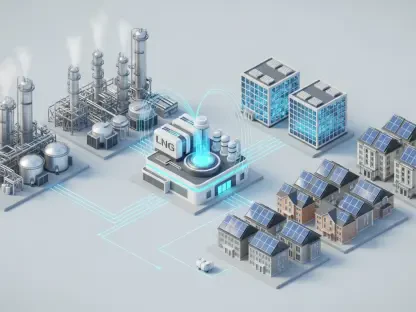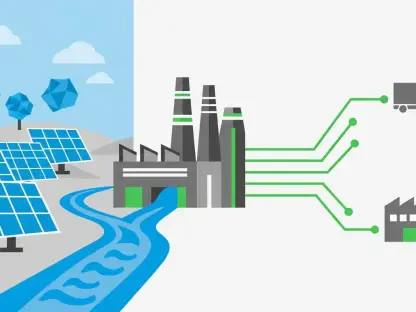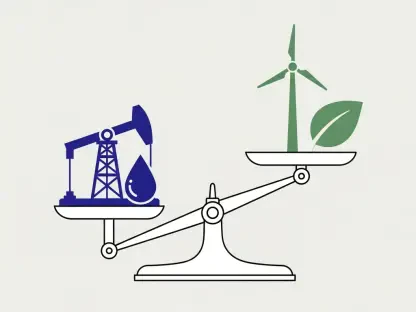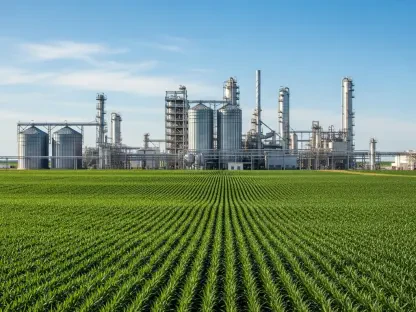The United Kingdom finds itself in the grip of an unprecedented energy crisis, with gas and electricity prices reaching staggering heights that are squeezing households and businesses alike, creating a financial strain across the nation. The energy regulator, Ofgem, has set the annual price cap for an average household at £1,755, marking a dramatic increase of over £600 since its introduction in 2019. Beyond the household level, industrial electricity costs in the UK have surged to the highest among developed nations, far exceeding rates in countries like France and Germany. This relentless rise is more than just a financial burden; it poses a severe threat to economic stability and daily life, challenging the ambitions of Prime Minister Keir Starmer’s administration to drive growth. The implications ripple through every sector, raising pressing questions about the root causes of this crisis and whether relief is on the horizon. As manufacturing falters and bills mount, the urgency to understand and address these soaring costs has never been greater.
Unpacking the Role of International Gas Price Volatility
A central driver behind the escalating energy costs in the UK lies in the unpredictable swings of international gas prices, which heavily influence the nation’s energy market. Gas constitutes roughly 45% of the UK’s energy expenditure and frequently sets the benchmark for overall pricing due to the marginal cost system. In this framework, the most expensive energy source—often gas—determines the rate during half-hourly auctions, resulting in gas dictating prices 98% of the time in the UK, a stark contrast to the 39% average across the European Union. This heavy dependence means that the benefits of cheaper renewable energy sources rarely trickle down to consumers, keeping bills persistently high even when alternatives are available.
The volatility of gas prices was exacerbated by global events, including the aftermath of the COVID-19 pandemic and the geopolitical turmoil following Russia’s invasion of Ukraine in 2022, which triggered a staggering 54% hike in the price cap that April. Although wholesale gas prices have since moderated to some extent, they remain over 40% higher than levels seen at the end of 2021. However, gas isn’t the sole culprit in inflating bills; electricity costs are also burdened with additional charges such as network fees, supplier operating expenses, subsidies for green initiatives, and taxes like VAT. Together, these elements account for more than half of a typical electricity bill, compounding the financial strain on both households and businesses and revealing a complex web of factors beyond mere market fluctuations.
The Burden of Net Zero Commitments
The UK’s ambitious goal to achieve net zero emissions by 2050 introduces a significant layer of cost to energy bills through various levies and subsidies aimed at fostering a greener future. These financial mechanisms support renewable energy projects, upgrades to the national grid, and innovative efforts like carbon capture, with an estimated annual price tag of £25.8 billion. Specific programs, such as Contracts for Difference (CfD), ensure low-carbon generators receive a guaranteed price for their output, adding approximately £27 to the average household bill in 2024. For businesses, the burden is even heavier, with additional taxes like the Climate Change Levy impacting their bottom line without the protection of a price cap that shields domestic consumers.
Voices from industry, including prominent groups like the Confederation of British Industry, have raised concerns that these green levies place an unfair load on consumers and risk undermining confidence in renewable investments if public tolerance wanes. On the other hand, advocates for net zero policies argue that transitioning away from volatile fossil fuels, particularly gas, will ultimately stabilize and reduce energy costs over the long haul. This debate encapsulates a critical tension between enduring immediate financial pain for the promise of future savings and sustainability, a balance that policymakers must navigate carefully to maintain both economic stability and environmental progress.
Structural Challenges in Energy Pricing Mechanisms
At the heart of the UK’s high energy costs lies a contentious pricing structure known as marginal cost pricing, which ties rates to the most expensive energy source—typically gas—rather than reflecting the lower costs of renewables. This system ensures that even when cleaner, cheaper energy is available, consumers are often stuck paying rates dictated by the priciest option on the grid. Critics argue that this approach prevents the public from benefiting from the growing availability of wind and solar power, perpetuating a cycle of inflated bills despite advancements in sustainable energy production.
Alternative models, such as zonal pricing, have been proposed to address these disparities by setting different electricity rates based on geographic proximity to renewable energy sources, potentially lowering costs in areas close to wind farms or solar arrays. However, the government rejected this idea, citing risks of creating a “postcode lottery” where energy affordability varies widely by location, alongside fears of deterring crucial investments during a pivotal time for the energy transition. This decision to maintain a single national wholesale price highlights the challenge of reforming a deeply entrenched system while striving to ensure fairness and security across diverse regions and consumer groups.
Grid Limitations Hindering Renewable Efficiency
The UK’s outdated energy infrastructure plays a significant role in driving up costs by failing to efficiently distribute power from renewable sources. Wind farms, such as the Viking plant in the Shetland Islands, frequently generate electricity that cannot be transmitted to other parts of the country due to grid constraints, resulting in wasted potential. This inefficiency leads to “curtailment” payments—compensation to producers for shutting down when the grid is overloaded—costing taxpayers a staggering £1 billion in 2024 alone. Such waste not only frustrates efforts to lower bills but also underscores the urgent need for modernization.
Upgrading the national grid to better accommodate renewable energy is widely seen as essential, yet the associated costs are substantial and often passed on to consumers through additional levies. This creates a frustrating loop where the push for cleaner energy inadvertently contributes to higher prices in the short term. Addressing these infrastructure bottlenecks is critical to maximizing the benefits of renewables and reducing long-term costs, but it requires significant investment and strategic planning to ensure that the financial burden does not disproportionately impact those already struggling with soaring energy bills.
Energy Imports and the Threat to Security
A profound vulnerability in the UK’s energy landscape stems from its substantial dependence on imported oil and gas, which heightens exposure to global market volatility and geopolitical instability. In 2024, a striking 43.8% of the nation’s energy consumption was sourced from abroad, costing a net £20.9 billion. Nearly half of the UK’s gas and 44% of its oil come from foreign suppliers, with significant reliance on Norway, which has signaled potential reductions in future supply. Without a shift toward greater domestic production, projections suggest this dependency could climb to 70% by 2030, amplifying risks and costs.
This reliance on imports leaves the UK economy susceptible to external shocks, as price spikes and supply disruptions abroad directly translate to higher bills at home. Energy security experts stress the importance of bolstering local energy sources to mitigate these dangers, yet government policies banning new North Sea oil exploration and fracking have sparked debate. Balancing the need for immediate energy security with long-term environmental goals remains a contentious issue, as the nation grapples with the dual challenge of affordability and reducing its carbon footprint in an increasingly uncertain global market.
Political Divisions Over Energy Strategy
The energy price crisis has ignited fierce political debate in the UK, with sharply contrasting visions on how to tackle the issue. The Labour government, under Keir Starmer, is committed to accelerating the shift to clean energy, targeting 95% low-carbon electricity by 2030 through initiatives like a state-owned energy company, mini nuclear power stations, and widespread subsidies for insulation and renewable projects. This approach prioritizes long-term stability by reducing dependence on volatile international gas markets, though critics highlight the lengthy timelines and hefty costs of major projects like Sizewell C.
Opposition parties, including the Conservatives led by Kemi Badenoch and Reform UK under Nigel Farage, advocate for more immediate relief by abandoning or scaling back net zero commitments. Their proposals focus on maximizing domestic oil and gas extraction to cut bills quickly, with some even suggesting taxes on renewables as a countermeasure. This ideological split mirrors a broader conflict between addressing urgent affordability concerns and investing in a sustainable future, a divide that complicates Labour’s broader economic growth objectives as high energy costs continue to weigh heavily on both households and industries.
Economic Consequences and Industrial Decline
The relentless climb in energy prices is delivering a severe blow to the UK’s industrial sectors, undermining the nation’s economic competitiveness on a global scale. Manufacturing industries, particularly energy-intensive ones like cement and metals, are seeing output decline as costs become unsustainable, pushing many to rely on imports rather than domestic production. High-profile cases, such as British Steel’s struggles with unaffordable energy bills, illustrate the tangible impact on jobs and industrial capacity, signaling a worrying trend for the broader economy.
Beyond immediate industrial challenges, fiscal analyses from bodies like the Office for Budget Responsibility warn of long-term economic risks tied to both climate change and the costs of net zero policies. These projections suggest that transitioning to a greener economy could shave significant percentages off GDP in the coming decades, compounded by declining revenues from traditional sources like fuel duties. The intersection of soaring energy costs and these fiscal concerns underscores the pressing need for a coherent strategy that supports industry while navigating the expensive shift to sustainable energy, ensuring that the UK does not sacrifice its economic foundation in pursuit of environmental goals.
Charting a Path Forward Through the Energy Crisis
Reflecting on the multifaceted energy crisis that has gripped the UK, it becomes clear that soaring prices stem from a tangled mix of volatile global gas markets, costly net zero policies, outdated pricing systems, grid inefficiencies, import reliance, and deep political divides. Each factor plays a critical role in pushing bills to record levels, challenging both household budgets and industrial survival. The economic fallout, particularly the strain on manufacturing, highlights the urgency of addressing these issues to prevent lasting damage to the nation’s competitive edge.
Looking ahead, actionable steps must focus on modernizing the national grid to harness renewable energy more effectively, thereby reducing waste and curtailment costs. Simultaneously, policies should aim to balance the immediate burden of green levies by exploring alternative funding mechanisms that do not disproportionately hit consumers. Enhancing domestic energy production, while carefully weighing environmental impacts, could lessen vulnerability to international shocks. Finally, fostering bipartisan dialogue to bridge the gap between short-term relief and long-term sustainability will be essential to crafting a resilient energy strategy that supports both economic growth and climate goals.









